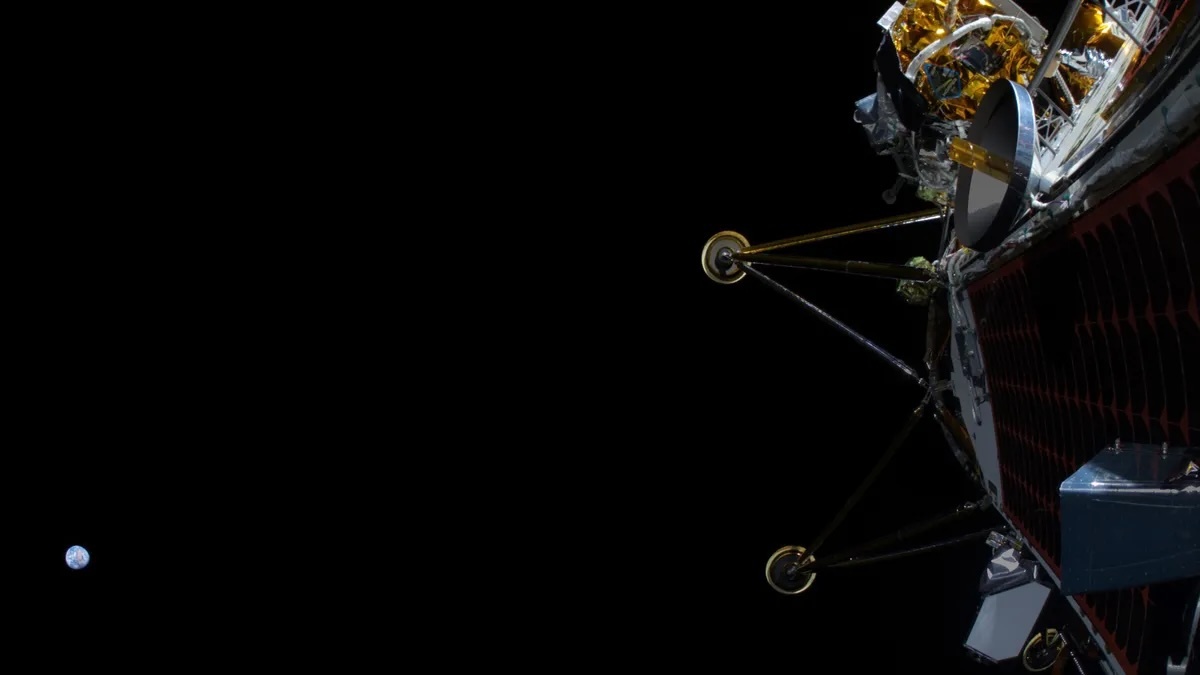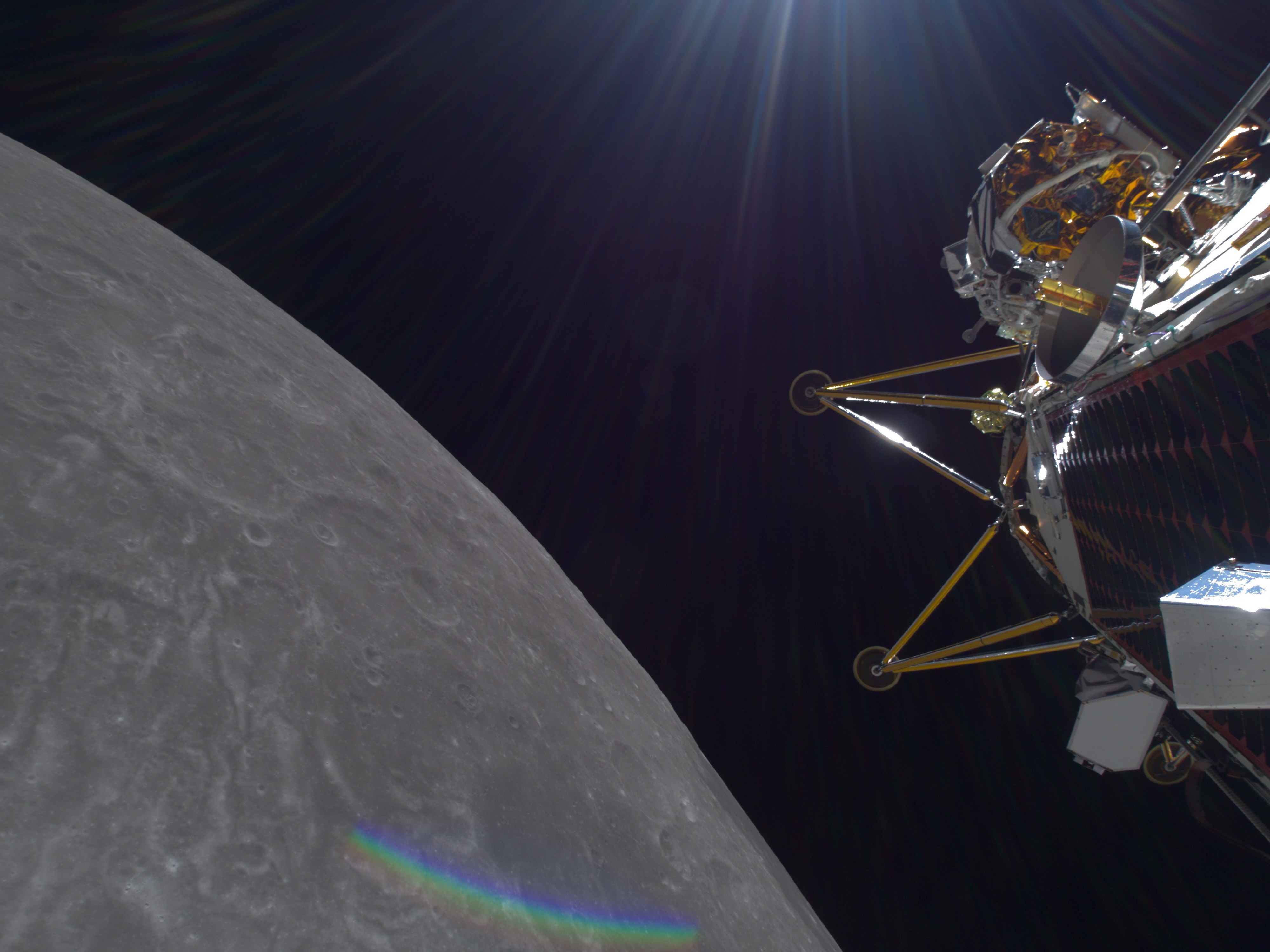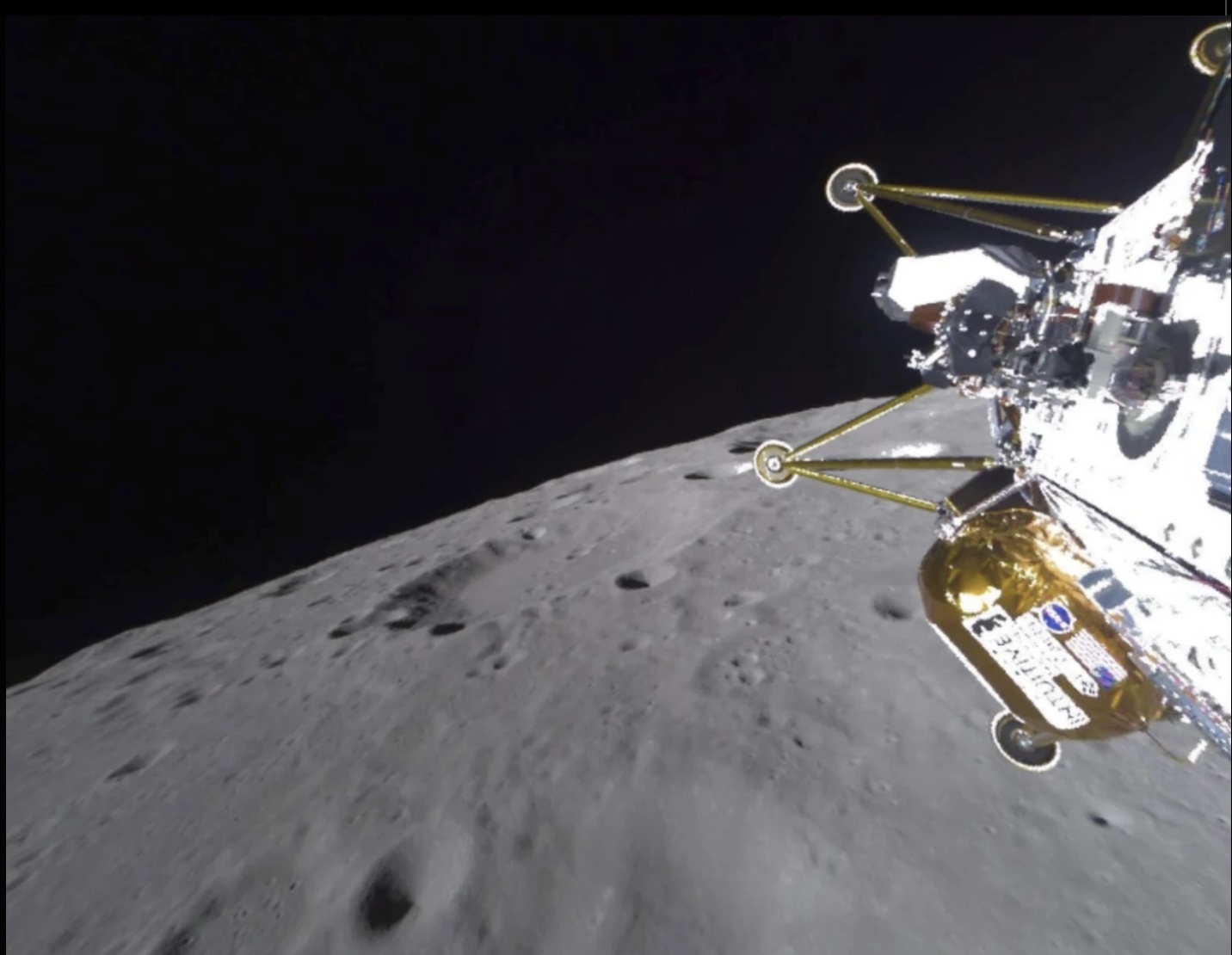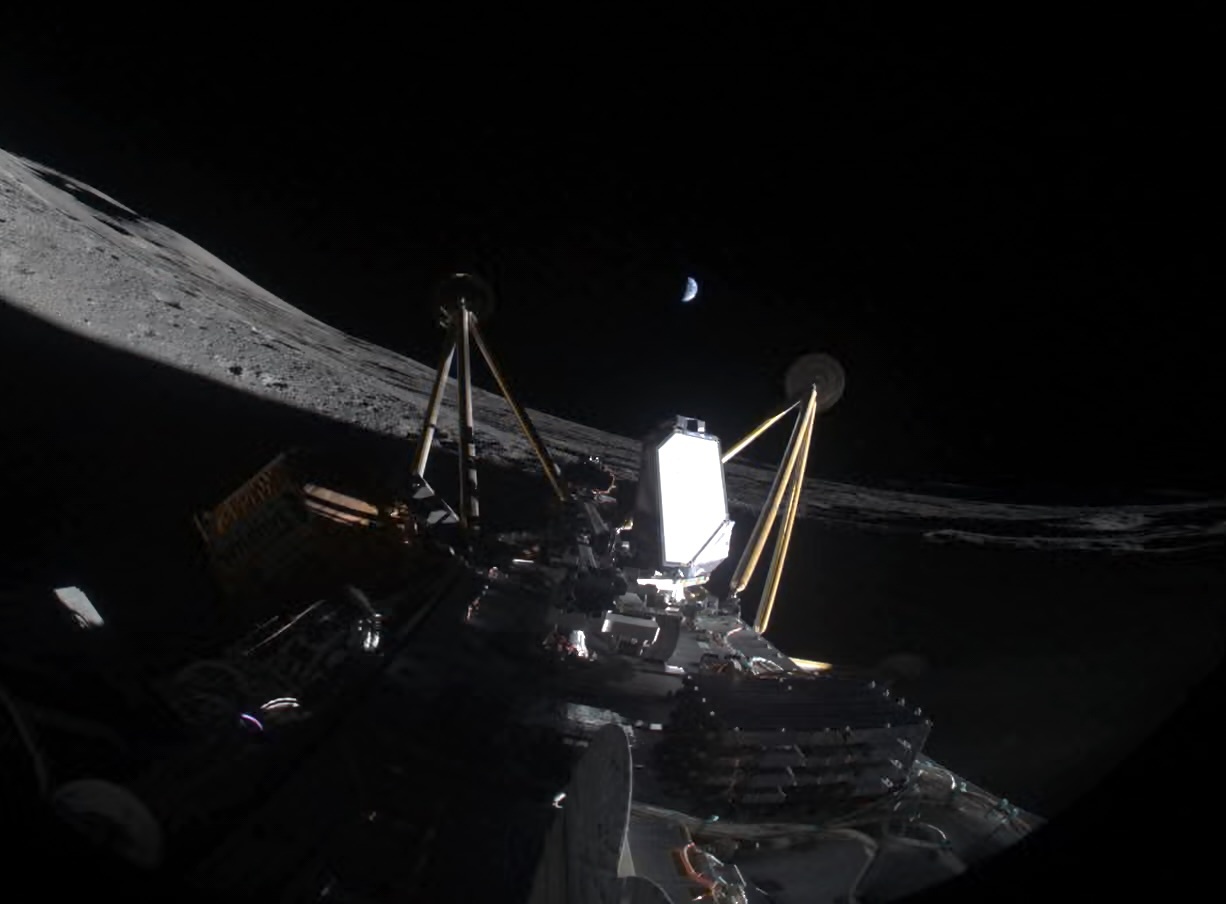5.03.2025
Private Athena moon lander enters lunar orbit ahead of March 6 touchdown try
"Athena continues to be in excellent health and is expected to send lunar orbit selfies over the next two days before a landing attempt on March 6."

Intuitive Machines' second moon lander, named Athena, snapped this deep-space selfie with Earth in the background on March 1, 2025. (Image credit: Intuitive Machines)
Intuitive Machines' second lunar lander has made it to the moon.
The Athena lander fired its engines for eight minutes and 12 seconds on Monday (March 3), slowing the spacecraft down and entering lunar orbit. Athena is now all set to make a landing attempt later this week.
The mission's flight team applauded a successful lunar orbit insertion after engine shutdown was confirmed, a video from Houston-based Intuitive Machines showed.
"Athena completed her scheduled 492-second main engine Lunar Orbit Insertion (LOI) burn at 6:27 a.m. CST on March 3 and is currently orbiting the moon," Intuitive Machines stated in a post on X on Monday.
Flight controllers will next analyze data to verify the lander's targeted circular orbit in order to confirm the time of Athena's expected landing attempt, which is slated for Thursday.
"Athena continues to be in excellent health and is expected to send lunar orbit selfies over the next two days before a landing attempt on March 6," the X post continued.
The Athena mission, also known as IM-2, launched on a SpaceX Falcon 9 rocket from Cape Canaveral on Feb. 26.
If all goes well, Athena will land near the moon's south pole. There, it will hunt for lunar water using a payload called PRIME-1 ("Polar Resources Ice Mining Experiment 1"), which consists of a deep-digging drill and a mass spectrometer. It also carries a hopping spacecraft called Grace designed to explore a crater near the landing site, and MAPP, a small rover from the Colorado company Lunar Outpost.
Athena entered lunar orbit just a day after fellow Texas company Firefly Aerospace aced its own lunar landing, with the Blue Ghost lander successfully touching down on the moon at Mare Crisium.
Both Blue Ghost and Athena are part of NASA's Commercial Lunar Payload Services (CLPS) program, which seeks to send the agency's science payloads to the moon on privately developed landers.
Athena's lunar orbit insertion also follows up on Intuitive Machines' historic achievement with its first lander, the Odysseus IM-1 spacecraft, which in February 2024 became the first-ever successful moon landing by a private spacecraft, despite tipping over.
Meanwhile, Japanese private space exploration company ispace is also headed for the moon. Its Resilience lander launched along with Blue Ghost on Jan. 15 and is currently on a low-energy trajectory to the moon with the aim of setting up a landing attempt in late May or early June.
Quelle: SC
----
Update: 6.03.2025
.
NASA Sets Coverage for Intuitive Machines’ Second Private Moon Landing

Carrying NASA technology demonstrations and science investigations, Intuitive Machines is targeting their Moon landing no earlier than 12:32 p.m. EST on Thursday, March 6. The company’s Nova-C lunar lander is slated to land in Mons Mouton, a lunar plateau near the Moon’s South Pole, as part of NASA’s CLPS (Commercial Lunar Payload Services) initiative and Artemis campaign to establish a long-term lunar presence.
Watch live landing coverage of the Intuitive Machines 2 (IM-2) landing, hosted by NASA and Intuitive Machines, on NASA+ starting no earlier than 11:30 a.m., approximately 60 minutes before touchdown. Beginning at 11 a.m. the agency will share blog updates as landing milestones occur.
Following the Moon landing, NASA and Intuitive Machines will host a news conference from NASA’s Johnson Space Center in Houston to discuss the mission, technology demonstrations, and science opportunities that lie ahead as lunar surface operations begin.
U.S. media interested in participating in person must request accreditation by 4 p.m. Wednesday, March 5, by contacting the NASA Johnson newsroom at 281-483-5111 or jsccommu@mail.nasa.gov. A copy of NASA’s media accreditation policy is online. To ask questions via phone, all media must RSVP by 4 p.m. March 5 to the NASA Johnson Newsroom, and dial in at least 15 minutes before the briefing begins.
Full coverage of the IM-2 mission includes (all times Eastern):
Thursday, March 6
- 11:30 a.m. – Landing coverage begins on NASA+
- 12:32 p.m. – Landing
- 4 p.m. – Post-landing news conference on NASA+
After landing, NASA and Intuitive Machines leaders will participate in the news conference:
- Nicky Fox, associate administrator, Science Mission Directorate, NASA Headquarters
- Clayton Turner, associate administrator, Space Technology Mission Directorate, NASA Headquarters
- Joel Kearns, deputy associate administrator for exploration, Science Mission Directorate, NASA Headquarters
- Steve Altemus, CEO, Intuitive Machines
- Tim Crain, chief growth officer, Intuitive Machines
The IM-2 mission launched at 7:16 p.m. Feb. 26 on a SpaceX Falcon 9 rocket from Launch Complex 39A at NASA’s Kennedy Space Center in Florida. The lander is carrying NASA technology that will measure the potential presence of resources from lunar soil that could be extracted and used by future explorers to produce fuel or breathable oxygen.
In addition, a passive Laser Retroreflector Array on the top deck of the lander will bounce laser light back at any orbiting or incoming spacecraft to give future spacecraft a permanent reference point on the lunar surface. Other technologies on this delivery will demonstrate a robust cellular network to help future astronauts communicate and deploy a propulsive drone that can hop across the lunar surface to navigate its challenging terrain.
NASA continues to work with multiple American companies to deliver technology and science to the lunar surface through the agency’s CLPS initiative. This pool of companies may bid on contracts for end-to-end lunar delivery services, including payload integration and operations, launching from Earth, and landing on the surface of the Moon. NASA’s CLPS contracts are indefinite-delivery/indefinite-quantity contracts with a cumulative maximum value of $2.6 billion through 2028. The agency awarded Intuitive Machines the contract to send NASA science investigations and technology demonstrations to the Moon using its American-designed and -manufactured lunar lander for approximately $62.5 million.
Through the Artemis campaign, commercial robotic deliveries will test technologies, perform science experiments, and demonstrate capabilities on and around the Moon to help NASA explore in advance of Artemis Generation astronaut missions to the lunar surface, and ultimately crewed missions to Mars.
Quelle: NASA
----
Update: 7.03.2025
.
Private lunar lander may have fallen over while touching down near the moon’s south pole

CAPE CANAVERAL, Fla. — A privately owned lunar lander touched down on the moon with a drill, drone and rovers for NASA and other customers Thursday, but quickly ran into trouble and may have fallen over.
Intuitive Machines said it was uncertain whether its Athena lander was upright near the moon’s south pole — standing 15 feet (4.7 meters) tall — or lying sideways like its first spacecraft from a year ago. Controllers rushed to turn off some of the lander’s equipment to conserve power while trying to determine what went wrong.
It was the second moon landing this week by a Texas company under NASA’s commercial lunar delivery program. Sunday’s touchdown was a complete success.
Intuitive Machines’ newest Athena lander dropped out of lunar orbit as planned. The hourlong descent appeared to go well until the final approach when the laser navigation system began acting up. It took a while for Mission Control to confirm touchdown.
“We’re on the surface,” reported mission director and co-founder Tim Crain. A few minutes later, he repeated, “It looks like we’re down ... We are working to evaluate exactly what our orientation is on the surface.”
Hours after the landing, Intuitive Machines CEO Steve Altemus there was conflicting data about how Athena landed and whether it was on its side. The lander was near the intended target site, but a sweep by NASA’s Lunar Reconnaissance Orbiter in the coming days will confirm its position and orientation, he said.
Launched last week, Athena was communicating with controllers more than 230,000 miles (375,000 kilometers) away and generating solar power, officials said. Mission managers worked to salvage the mission to see whether the drill can be turned on and the drone can be deployed to hop into a crater.
“Obviously, without knowing the exact orientation of the lander, it’s hard to say exactly what science we will and will not be able to do,” said NASA’s top science officer Nicky Fox.
Intuitive Machines last year put the U.S. back on the moon despite its lander tipping on its side.
On Sunday, Firefly Aerospace became the first private entity to achieve complete success with its Blue Ghost lunar lander, on the northeastern edge of the near side of the moon. A vacuum already has collected lunar dirt for analysis and a dust shield has shaken off the abrasive particles that cling to everything.
Intuitive Machines was aiming this time for a mountain plateau just 100 miles (160 kilometers) from the south pole, much closer than before. It reached the plateau, but Intuitive Machines was not sure how near it was to the precise targeted spot.
This week’s back-to-back moon landings are part of NASA’s commercial lunar delivery program meant to get the space agency’s experiments to the gray, dusty surface and jumpstart business. The commercial landers are also seen as scouts for the astronauts who will follow later this decade under NASA’s Artemis program, the successor to Apollo.
NASA officials said before the landing that they knew going in that some of the low-cost missions would fail. But with more private missions to the moon, that increased the number of experiments getting there.
NASA spent tens of millions of dollars on the ice drill and two other instruments riding on Athena, and paid an additional $62 million for the lift. Most of the experiments were from private companies, including the two rovers. The rocket-powered drone came from Intuitive Machines — it’s meant to hop into a permanently shadowed crater near the landing site in search of frozen water.
To lower costs even more, Intuitive Machines shared its SpaceX rocket launch with three spacecraft that went their separate ways. Two of them — NASA’s Lunar Trailblazer and AstroForge’s asteroid-chasing Odin — are in jeopardy.
NASA said this week that Lunar Trailblazer is spinning without radio contact and won’t reach its intended orbit around the moon for science observations. Odin is also silent, with its planned asteroid flyby unlikely.
As for Athena, Intuitive Machines made dozens of repairs and upgrades following the company’s sideways touchdown by its first lander. It still managed to operate briefly, ending America’s moon-landing drought of more than 50 years.
Until then, the U.S. had not landed on the moon since Apollo 17 in 1972. No one else has sent astronauts to the moon, the overriding goal of NASA’s Artemis program. And only four other countries have successfully landed robotic spacecraft on the moon: Russia, China, India and Japan.
Quelle: AP
IM-2 lunar lander on its side after touchdown
WASHINGTON — The second lunar lander mission by Intuitive Machines reached the surface of the moon March 6 but appears to be resting on its side, hampering its planned science and technology demonstration mission.
At a briefing about three and a half hours after the Athena lander reached the south polar region of the moon on the IM-2 mission, executive said the lander was “somewhat on its side” although its exact orientation remains uncertain.
“We’ve been very successful to this point, however, I do have to tell you that we don’t believe we’re in the correct attitude on the surface of the moon,” Steve Altemus, chief executive of Intuitive Machines, said at the briefing.
Later, he said that engineers were getting conflicting data after landing that suggested the engine was firing in an idle mode, which would require the lander to be upright, while data from an inertial measuring unit (IMU) on the lander indicated the lander is on its side. The engine data turned out be gas in its combustion chamber. “That IMU data is the piece of data that says we’re oriented somewhat on our side.”
It wasn’t clear what caused the spacecraft to land on its side, but Altemus and Tim Crain, senior vice president of Intuitive Machines, said laser altimeters were providing some “noisy” data during testing in lunar orbit. “It just remained noisy all the way until touchdown,” Crain said. “That’s where we’re going to look as we investigate what impact that might have had on the system.”
Despite being on its side, the lander is generating some power and is transmitting telemetry back to Earth. Crain said that engineers are trying to piece together the exact attitude and orientation of the lander, which will help them determine how much power they can generate and the thermal conditions of the spacecraft.
That will help determine what payloads can operate and to what degree. “We know that we can communicate with the payloads. We can talk to them and command them on and off,” Altemus said. Once they better understand the state of the lander, he said they will work with the payloads to prioritize their activities “that would allow us to capture some mission objectives.” They added it was unclear how it would affect deployment of a NASA-provided drill as well as a “hopper” vehicle developed by Intuitive Machines and two small rovers.
The flawed landing took place less than five days after Firefly Aerospace had a successful landing of its Blue Ghost 1 lander elsewhere on the moon. “They both have different challenges,” Nicky Fox, NASA associate administrator for science, said of the two lander missions at the briefing. “I certainly don’t want to make it sound like Firefly was an easy landing. Landing on the moon is hard.”
Investors in Intuitive Machines were not comforted by those comments, though. Shares in the company closed 20% lower March 6, with the drop taking place after the landing. In after-hours trading, shares fell even further, down by another third two hours after the markets closed.
Descent into uncertainty
The Athena lander was scheduled to land around 12:32 p.m. Eastern on the IM-2 mission after performing a long braking burn, then changing orientation to perform a vertical landing. Telemetry displayed by the company on its webcast appeared to show the lander conducting that braking burn as expected, but closer to the landing time the telemetry appeared frozen or garbled, including at one point where it indicated the lander was several kilometers below the surface.
For about 20 minutes after the planned landing time, mission controllers reported getting telemetry that indicated the lander was on the surface and generating power. However, the orientation of the lander was uncertain.
“Alright team, keep working the problem,” Crain, flight director for the landing, said in mission control about 15 minutes after the scheduled landing time. He said controllers were shutting down unnecessary systems now that the lander appeared to be on the surface.
“We are generating power. We are communicating through our telemetry radio and we are working to evaluate exactly what our orientation is on the surface,” he said. That included analyzing images taken by the lander after landing, although those were not immediately released.
IM-2 mission plans
The intended landing site was Mons Mouton, a plateau about the size of Delaware in the south polar region of the moon. The region is of strategic interest to NASA given the potential for regions around the south pole to have water ice deposits that are both a priority for scientists and could support future human expeditions. “We hope that that’s going to provide opportunities for extraordinary science in extraordinary places,” said Fox at a pre-launch briefing.
IM-2 launched Feb. 26 on a Falcon 9, which placed the Athena lander on a translunar trajectory. The spacecraft performed a 492-second burn of its main engine early March 3, entering orbit around the moon. A maneuver at 5:33 a.m. Eastern March 6 put the lander into its descent orbit, from which it attempted the landing.
The lander’s main NASA payload is the Polar Resources Ice Mining Experiment 1 (PRIME-1). It features a drill designed to penetrate up to a meter into the surface and a spectrometer to measure any volatiles, like water ice, the drill passes through below the surface.
PRIME-1 is flying as part of NASA’s Commercial Lunar Payload Services (CLPS) program under a task order currently valued at $62.5 million. That task order also includes a laser retroreflector, a small passive payload NASA includes on many lunar landers.
Intuitive Machines is flying several commercial payloads on IM-2, including its own Micro Nova Hopper, a vehicle designed to hop across the lunar surface using its own propulsion system. The hopper, named Grace, carries a camera system and instruments the German aerospace agency DLR and Hungarian company Puli Space. Intuitive Machines plans to perform at least five hops of Grace during the mission, including into a crater near the landing site.
Another commercial payload is a communications system from Nokia, which will test the ability to use 4G/LTE networks on the moon. It will attempt communications both with the Grace hopper and another commercial payload, the Mobile Autonomous Prospecting Platform rover from Lunar Outpost. Both the Nokia payload and Grace are supported by awards from NASA’s Tipping Point space technology development program.
Also on board is Yaoki, a very small rover from Japanese company Dymon Co. Ltd.; Freedom, a data center from Lonestar Data Holdings; and thermal protection technologies from Columbia Sportwear.
IM-2 is the second mission by Intuitive Machines, both flown as part of the NASA CLPS program. The IM-1 mission landed on the moon in February 2024 but hit the surface faster than expected, snapping a landing leg and causing the Odysseus lander to fall on its side. The company was still able to operate the lander for about a week, collecting some data from its payloads.
The company blamed the hard landing on a laser altimeter that could not operate because a safety system was not removed from it before launch as intended. Trent Martin, senior vice president of space systems at Intuitive Machines, said before launch that the company addressed 85 things that did not go according to plan on IM-1, like that laser altimeter, on IM-2.
This mission is the fourth for the CLPS program overall. Astrobotic’s Peregrine lander launched in January 2024 but suffered a problem with its propulsion system hours after launch, preventing the spacecraft from attempting a landing.
Firefly Aerospace’s Blue Ghost 1 lander successfully landed on the moon March 2, a month and a half after its launch. That lander, carrying a set of 10 NASA payloads, will operate at its landing site in Mare Crisium in the northeastern quadrant of the near side of the moon through lunar sunset March 16.
Quelle: SN
----
Update: 9.03.2025
.
Athena spacecraft declared dead after toppling over on moon
Robotic private spacecraft touched down about 250 meters from its intended landing site on Thursday

Intuitive Machines LLC's Athena spacecraft on its side after landing on the Moon, on 6 March 2025. Photograph: Intuitive Machines
A robotic private spacecraft designed to provide crucial data for returning humans to the moon toppled over as it landed on the lunar surface, bringing an immediate and premature end to the mission, its operators said on Friday.
Athena, a probe launched by the Texas-based company Intuitive Machines (IM) last month, touched down about 250 meters from its intended landing site near the moon’s south pole on Thursday. Initially at least, it was generating some power and sending information to Earth as engineers worked to make sense of data showing an “incorrect attitude”.
On Friday, however, IM declared Athena dead.
“With the direction of the sun, the orientation of the solar panels, and extreme cold temperatures in the crater, Intuitive Machines does not expect Athena to recharge,” it said in a statement confirming that the 15ft (4.6-meter) spacecraft was on its side.
“The mission has concluded and teams are continuing to assess the data collected throughout the mission.”
The failure of Athena, which was packed with scientific probes and experiments that Nasa was relying on as it prepares to send astronauts back to the moon for the first time since 1972, was almost identical to IM’s first moon landing in February 2024.
The Odysseus spacecraft became the first private mission to reach the moon, but skidded across the surface, broke a leg and toppled over. Athena had the same tall, thin design that some experts had feared could lead to a repeat of the accident.
Lost with the Athena lander were hundreds of millions of dollars worth of equipment, including Nasa’s Trident regolith drill, which was to have excavated soil in a search for water and other life-supporting constituents.
The lander also carried three robotic mobile probes, one of which, the mobile autonomous prospecting platform (Mapp), built by the Colorado company Lunar Outpost, was the first commercially built rover to reach the moon.
Athena’s scheduled 10-to-14-day mission, known as IM-2, was one of 10 contracted by Nasa’s $2.6bn commercial lunar payload services (CLPS) program to encourage private industry to fly experiments and other equipment to the moon in advance of the arrival of the crewed Artemis 3 mission, currently scheduled for mid-2027.
Another was the successful landing on Sunday of Firefly Aerospace’s Blue Ghost Mission 1, which touched down near Mons Latreille, in Mare Crisium on the moon’s north-eastern near side.
Painting Athena’s failure in a more positive light, the IM statement said its arrival marked “the most southernmost lunar landing and surface operations ever achieved”.
“This southern pole region is lit by harsh sun angles and limited direct communication with the Earth,” it said.
“This area has been avoided due to its rugged terrain and Intuitive Machines believes the insights and achievements from IM-2 will open this region for further space exploration.”
